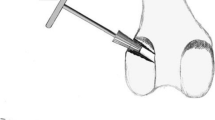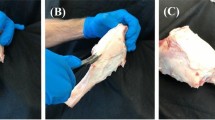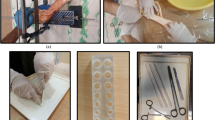Abstract
To overcome the disadvantages of interference-screw fixation of bone–patellar tendon–bone (BPTB) grafts, new fixation techniques for anterior cruciate ligament (ACL) grafts using biodegradable pins have been developed. The hypothesis of the present study was that cross-pin fixation techniques provide a primary stability that is comparable to that of interference screws. A biomechanical in vitro study was discussed. Human BPTB grafts of 8, 9 and 10 mm diameter were fixed in bovine knees with biodegradable cross pins (diameter: 2.0, 2.7 or 3.2 mm) or biodegradable interference screws. Stiffness and ultimate load were evaluated. For 9 and 10 mm BPTB grafts, no statistically significant difference in maximum load and stiffness was found between the four fixation techniques tested. For 8 mm bone blocks the maximum load of the 3.2 mm pins (274.2 N) was significantly lower than for the 2.0 mm pins (479.8 N) and the interference screws (504.0 N). Predominant failure mode in this group was bone-block fracture. Thicker grafts (9 and 10 mm) fixed with the 2.0 mm pins predominantly failed by implant fracture. Femoral fixation of 8, 9 and 10 mm BPTB grafts using cross pins leads to biomechanical properties that are comparable to biodegradable interference screws when tested by a single-cycle load to failure. Cross pins provide a rigid fixation for 9 and 10 mm BPTB grafts.



Similar content being viewed by others
References
Abate JA, Fadale PD, Hustyn MJ, Walsh WR (1998) Initial fixation strength of polylactic acid interference screws in anterior cruciate ligament reconstruction. Arthroscopy 14:278–284
Adriani E, Bellelli A, Avitto A, David V (2001) [New femoral fixation system for tendon transplantation in ACL reconstruction. Preliminary experience with MR imaging]. Radiol Med (Torino) 102:211–216
Aglietti P, Buzzi R, D’Andria S, Zaccherotti G (1993) Patellofemoral problems after anterior cruciate ligament reconstruction. Clin Orthop 288:1294–1297
Beynnon BD, Amis AA (1998) In vitro testing protocols for the cruciate ligaments and ligament reconstructions. Knee Surg Sports Traumatol Arthrosc 6:70–76
Brand J, Weiler A, Caborn DNM, Brown C, Johnson D (2000) Graft fixation in cruciate ligament reconstruction. Am J Sports Med 28:761–773
Brown G, Pena F, Grondtfeld T, Labadie D, Engebretsen L (1996) Fixation strength of interference screw fixation in bovine, young human, and elderly human cadaver knees: Influence of insertion torque, tunnel bone block gap, and interference. Knee Surg Sports Traumatol Arthrosc 3:238–244
Caborn DNM, Urban WP, Johnson DL (1997) Biomechanical comparison between BioScrew and titaneum alloy interfernce screws for bone-patellar tendon graft fixation in anterior cruciate ligament reconstruction. Arthroscopy 10:524–529
Corsetti JR, Jackson (1996) Failure of anterior cruciate ligament reconstruction: the biological basis. Clin Orthop 325:42–49
Clancy WG, Narechania RG, Rosenberg TD, Gmeiner JG, Wisnefske DD, Lange TA (1981) Anterior and posterior cruciate ligament reconstruction in rhesus monkeys. J Bone Joint Surg Am 63:1270–1284
Frank CB, Jackson DW (1996) The science of reconstruction of the anterior cruciate ligament [current concepts review]. J Bone Joint Surg Am 79:1556–1576
Fu FH, Bennet CH, Ma B, Menetrey J, Lattermann C (2000) Current trends in anterior cruciate ligament reconstruction. Part II: Operative procedures and clinical correlations. Am J Sports Med 28:124–130
Gibson L, Asby M (1987) Cancellous bone. In: Gibson L (ed) Cellular solids. Pergamon, New York, pp 316–331
Hoffmann RFG, Peine R, Bail H, Südkamp NP, Weiler A (1999) Initial fixation strength of modified patellar tendon grafts for anatomic fixation in anterior cruciate ligament reconstruction. Arthroscopy 15:392–399
Höher J, Scheffler S, Withrow J et al (2000) Mechanical behavior of two hamstring graft constructs for reconstruction of the anterior cruciate ligament. J Orthop Res 15:461–465
Holden JP, Grood ES, Korvick DL, Cummings JF, Butler DL, Bylski-Austrow DI (1994) In vivo forces in the anterior cruciate ligament: direct measurements during walking and trotting in a quadrupled. J Biomech 27:517–526
Ishibashi Y, Rudy TW, Livesay GA et al (1997) The effect of anterior cruciate ligament graft fixation site at the tibia on knee stability: evaluation using a robotic testing system. Arthroscopy 13:177–182
Kurosaka M, Yoshiya S, Andrish (1987) A biomechanical conparison of different surgical techniques of graft fixation in anterior cruciate ligament reconstruction. Am J Sports Med 15:225–229
Kousa P, Jarvinen TL, Pohjonen T, Kannus P, Kotikoski M, Jarvinen M (1995) Fixation strength of a biodegradable screw in anterior ligament reconstruction. J Bone Joint Surg Br 77:901–905
Kousa P, Jarvinen TL, Pohjonen T, Kannus P, Jarvinen M (2001) Initial fixation strength of biodegradable and titaneum screws in anterior ligament reconstruction. Am J Sports Med 29:420–425
Lambert K (1983) Vascularized patellar tendon graft with rigid internal fixation for anterior cruciate ligament insufficiancy. Clin Orthop 172:85–89
Liu SH, Kabo JM, Osti L (1995) Biomechanics of two types of bone-tendon-bone graft for ACL reconstruction. J Bone Joint Surg Br 77:232–235
Markolf KL, Burchfield DM, Shapiro MM (1997) Biomechanical consequences of replacement of the anterior cruciate ligament with a patellar ligament allograft. Part II: Forces in the graft compared with forces in the intact ligament. J Bone Joint Surg Am 78:1728–1734
Morrison JB (1970) Function of the knee joint in normal walking. J Biomech 3:51–61
Morrison JB (1969) Function of the knee joint in various activities. Biomed Eng 4:573–580
Noyes FR, Butler DL, Grood ES, Zernicke RF, Hefzy MS (1984) Biomechanical analysis of human ligament grafts used in knee-ligament repairs and reconstructions. J Bone Joint Surg Am 66:344–350
Papageorgiou CD, Ma CB, Abramowitch SD, Clineff TD, Woo SL (2001) A multidisciplinary study of the healing of an intraarticular anterior cruciate ligament graft in a goat model. Am J Sports Med 29(5):620–626
Pena F, Grontvedt T, Brown GA, Aune AK, Engebretsen L (1996) Comparison of failure strength between metallic and absorbable interference screws: influence of insertion torque, tunnel-bone block gap, bone mineral density, and interference. Am J Sports Med 24:329–334
Rupp S, Hopf T, Hess T (1999) Resulting tensile forces in the human bone patellar tendon bone graft: direct force measurement in vitro. Arthroscopy 15:179–184
Rupp S, Krauss PW, Fritsch EW (1997) Fixation strength of a biodegradable interference screw and a press fit technique in anterior cruciate ligament reconstruction with a BPTB graft. Arthroscopy 13:61–65
Shelbourne KD, Gray T (1997) Anterior cruciate ligament reconstruction with autogenous patellar tendon graft followed by an accelerated rehabilitation program. A two to nine years follow up. J Bone Joint Surg Am 83:786–795
Shelbourne KK, Nitz (1990) Accelerated rehabilitation after anterior cruciate ligament reconstruction. Am J Sports Med 18:292–299
Weiler A, Windhagen H, Raschke M, Laumeyer A, Hoffmann R (1998) Biodegradable interference screw fixation exhibits pullout force and stiffness similar to titaneum screws. Am J Sports Med 26:119–128
Weiler A, Helling HJ, Kirch U, Zirbes TK, Rehm KE (1996) Foreign body reaction and the course of osteolysis after polyglycide implants for fracture fixation. J Bone Joint Surg Br 78:369–376
Weiler A, Hoffmann RF, Staehlin AC, Helling HJ, Südkamp NP (2000) Biodegradable implants in sports medicine: the biological base. Arthroscopy 16:305–321
Weimann A, Zantop T, Rümmler M, Hassenpflug J, Petersen W (2003) Primary stability of bone–patellar tendon–bone graft fixation with biodegradable pins. Arthroscopy 19:1097–1102
Acknowledgements
We want to thank Mr. S. Zander and Mr. A Studt for their expert technical assistance. We would also like to thank Mr. J. Hedderich from the Department of Medical Statistics of the Christian Albrechts University in Kiel for his help with the statistical analysis. The implants used in this study were kindly provided by Ethicon, Mitek Division (Norderstedt, Germany) and by Linvatec Biomaterials (Tampere, Finland). None of the authors received the financial support of any commercial party.
Author information
Authors and Affiliations
Corresponding author
Rights and permissions
About this article
Cite this article
Zantop, T., Welbers, B., Weimann, A. et al. Biomechanical evaluation of a new cross-pin technique for the fixation of different sized bone–patellar tendon–bone grafts. Knee Surg Sports Traumatol Arthrosc 12, 520–527 (2004). https://doi.org/10.1007/s00167-004-0509-5
Received:
Accepted:
Published:
Issue Date:
DOI: https://doi.org/10.1007/s00167-004-0509-5




